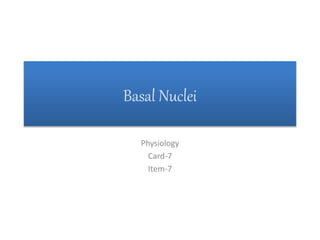
Functional Anatomy & physiology of the Basal nuclei
- 2. Parts of Basal Nuclei Definition • The basal ganglia are a collection of subcortical nuclei that are highly involved in regulating voluntary motor movements. Parts It consists of 5 parts: 1) Caudate Nucleus 2) Putamen (Caudate Nucleus + Putamen = Striatum) 3) Globus Pallidus (Putamen + Globus Pallidus = Lentiform Nucleus) 4) Subthalmic Nuclei 5) Substantia Nigra of the Midbrain
- 3. Connections of the Basal Nuclei Afferents (Inputs) to the basal ganglia include the following: 1) From the entire cerebral cortex - through the corticostriatal pathway, 2) From the substantia nigra - fibers arising in the pars compacta of the substantia nigra reach the striatum, forming the nigrostriatal connections. 3) From the thalamus - fibers from the thalamus to the basal ganglia form the thalamostriatal connections. 4) From the reticular formation of the brainstem- afferents from the reticular formation Efferents (Outputs) of the basal ganglia include the following: 1) Striatopallidal- From Striatum to Globus Pallidus 2) Striatonigral- From Striatum to Substantia Nigra pars reticulata
- 4. Direct Pathway • The specific way that the basal ganglia modifies movement depends largely on whether it goes through the direct pathway or the indirect pathway. • The direct pathway generally has an excitatory effect on the initial motor signal
- 5. Indirect Pathway • The indirect pathway takes a longer route through the basal ganglia and generally exerts a diminishing or inhibitory effect on the initial motor signal • The indirect pathway starts out similarly to the direct pathway in that the signal is generated in the Cortex and travels to the Striatum. However, it then exits the direct pathway into the External globus pallidus before traveling to the Subthalamic nucleus, the Internal globus pallidus, and finally the Thalamus.
- 6. Functions of the Basal Nuclei The functions of the basal ganglia are yet to be fully understood. However, the following are functions have been clearly established by now: • Planning and modulation of movement pathways • Reward processing and motivation • Decision making • Working memory • Eye movements • Moreover, the basal nuclei use proprioceptive feedback from the periphery to compare the movement patterns generated by the cerebral cortex with the actual movement. • Also, the basal ganglia have been shown to play an important role in motivation considering that the basal ganglia circuits are influenced heavily by extracellular dopamine.
- 7. Damage to Basal Nuclei Parkinson’s Disease: Parkinson’s disease is a neurodegenerative disorder that primarily affects the motor system. Specifically, Parkinson’s disease involves the death of dopaminergic neurons in the substantia nigra, leading to a general dopamine deficit in the brain. Symptoms of Parkinson’s Disease (TRAP) : T is for Tremor. – It is typically a resting & slow tremor, meaning that it is there most of the time but will disappear when someone initiates a voluntary movement. R is for Rigidity. – sustained way known as lead-pipe rigidity or in a ratchety click-click-click manner known as cogwheel rigidity A is for Akinesia and bradykinesia. – Absence or slowness of movement P is for Postural instability – A distinct lack of balance which tends to emerge late in the disease
- 8. Damage to Basal Nuclei HUNTINGTON’S DISEASE Definition : Huntington’s disease is a movement disorder that presents clinically as progressively worsening movement and behavioral problems. The hallmark movement abnormality seen in Huntington’s disease is chorea (a series of quick, jerky, flailing movements that resembles dancing) Cause: Huntington’s disease is an autosomal dominant genetic disorder involving mutations in the huntingtin gene on chromosome 4. • Here too many CAG repeats (more than 26) are produced. The gene becomes affected and begins to produce a mutant version of the huntingtin protein that damages neurons in the caudate. • Number of CAG repeats is directly correlated with the severity & onset of the disease